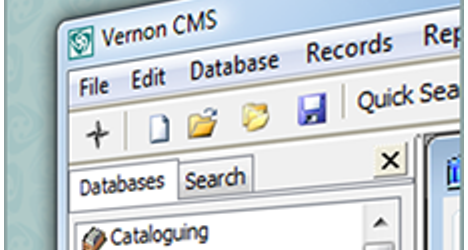The January 2014 issue of Database Trends and Applications features an article written by Joyce Wells titled Vernon Systems Discovers Revelation Software to be a Rare Find

With a unique depth of experience creating specialized software to support institutions with significant art and antique collections, Vernon Systems Limited, based in Auckland, New Zealand, has been solely dedicated to the Museum, Gallery and Heritage sector for over 25 years. Institutions around the world with collections of diverse types and sizes depend on Vernon Systems to provide sophisticated collection management and web access for cultural treasures, backed by the company’s trusted support. Vernon Systems, in turn, has long relied on Revelation Software’s OpenInsight.
An experienced provider of data conversion and customization, Vernon Systems also provides hosting and web design for online collections and is dedicated to developing innovative, well-designed products. Today, Vernon Systems has more than 180 customers spread around the globe, with most in Australia and New Zealand.
“We develop software to manage and share collections. The Vernon CMS [Collections Management System] includes sophisticated features for cataloguing objects and managing related activities such as conservation, loans, exhibitions and web access,” explains Matt Crozier, Development Manager for the Vernon CMS.
The Vernon CMS is a fully integrated desktop application requiring little maintenance or specialist IT expertise. The system can be easily installed or migrated to a different server. “Our products are at the core of our clients' primary business function. In museums, the Collections Management System is central to the information processes and workflow procedures for all key professional staff and decision makers,” said Crozier, who joined the company in 1988. He built and continues to maintain the majority of core underlying tools that make up the Vernon CMS. “Software acquisition at this level is a rigorous process, usually involving request for proposals or tender processes. To that end, key requirements are identified and solutions resolved up front,” he noted.
OpenInsight provides the foundation for the Vernon Collections Management System
Revelation Software’s products have provided the main development environment for Vernon Systems since it was founded in 1986, by Bil Vernon. Vernon, a systems analyst and accountant, was first introduced to Revelation version G2b by a colleague. Impressed that the Revelation 4GL toolset could be used to develop a sophisticated system with minimal 3GL programming, Vernon built a management system for an art gallery. He then extended it to a modular Collections Management System for use in museums and art galleries. When the system was well-received by the museums community, Bil Vernon founded Vernon Systems to develop and market the system, named “COLLECTION.”
“Our internal systems (such as Client, Correspondence, and Accounting systems) were also built in Revelation G2b, and remained in use right up into the 2000s,” added Crozier. However, as the company grew and took on new employees who were unfamiliar with DOS. “We built our own business systems using Revelation products but as our client base grew we had to dedicate more of our development resources to the product itself,” explained Crozier. As a result, he said, “We have since moved to pre-built third-party systems for our own internal processes, but we are still using OpenInsight for our Client and Prospect system.”
Over the years, Vernon Systems’ use of Revelation technology has evolved, both to meet user demand and stay current with new releases.
“Advanced Revelation 1.0 had been released just before we were ready to go into production with the COLLECTION system so we rebuilt the system for this environment. Some of the core business logic could be retained, but a lot of the user interface had to be redesigned,” recalled Crozier.
“From building several specified bespoke systems for our first clients in the U.S. and Australia, we developed a generic Collections Management System in Advanced Revelation 2.12 - 'Standard COLLECTION.' Eventually, all our tailored client systems were migrated to the standard product,” Crozier added.
Vernon Systems revamped the system again to use OpenInsight version 3.60 in the late 1990s. The product is currently on OpenInsight version 8.0.8 and Revelation is now working with Vernon Systems to migrate its system to OpenInsight 9.4.
An Appreciation for Revelation Software’s MultiValue Platform
Vernon Systems’ early migration in the 1990s from Advanced Revelation (DOS) to OpenInsight (Windows) meant redesigning the system and since OpenInsight at that time was quite new (version 2), the company took the time to evaluate other options, said Crozier. “We investigated what would be involved in redeveloping the system on a native SQL platform, but we came to realize just how vast and complex the system would be to build and maintain with a normalized back end. This gave us a renewed appreciation for how a MultiValue platform is easier to understand and modify. It is a natural fit for museum data where a lot of information is extensive and repeatable.”
In addition, he noted, the company realized that there was a significant amount of Advanced Revelation code that would remain intact in OpenInsight. “We found that Basic+ was still a good language for working with and manipulating data.”
Recently, Vernon has also put Revelation’s software to work as part of a new initiative. The Vernon CMS has been integrated with a radio frequency identification (RFID) system for tracking the movements of the collection. An RFID tag is attached to each object. Fixed RFID readers located at various points about the museum track collection item movement through the museum. When a reader detects the signal from a tag, details regarding the item and its location are automatically updated in the museum’s Vernon Collection Management System.
Revelation Helps Vernon Systems Address Customers’ Specialized Needs
The use of Revelation technology has helped Vernon Systems address its customers’ specialized and evolving needs. “The ease with which the system can be extended without affecting existing data is a huge bonus. Fields and indexes can be added without having to rebuild the database in an upgrade, for instance,” noted Crozier. “We allow for a certain degree of customization in the standard product, particularly with custom built data entry windows. These are very quick to develop and easy to maintain using our standard toolset. These can be incorporated into the standard product in a modular way that will not affect other customers, and are easy to deploy.”
Vernon Systems prides itself on its customer support. “We find it very easy to diagnose and interact with problems that customers may have. We are able to send them an update if they require one and it is very easy to apply. And, of course OpenInsight has deployment tools built in to be able to do that,” said Crozier.
In addition, as Vernon Systems’ customer base has grown to include institutions with different types of collections, the company has been able to address their needs, according to Crozier. “We have been able to expand the dictionary for different types of museums and collections. You can just add a dictionary item and it does not change your existing data at all. It just tacks on at the end of a record. That was one of the main reasons we went for the software in the first place and it continues to be very beneficial.”
OpenInsight’s Expanding Product Features
Revelation continues to expand its product features for customers. For example, Crozier said that in the future, O4W (OpenInsight for Web) would be useful for developing small web-based applications that support the main Collections Management System, particularly for use on tablets. An application about a museum’s storage areas and inventory and location control needs to be mobile, simple and quick.
At the same time, Revelation has continued the philosophy behind the 4GL paradigm, maintaining a development environment where systems analysts can build sophisticated applications without requiring extensive programming and technical knowledge, noted Crozier. “The world has moved on to internet-based applications, and typical web development environments still require a good deal of varied technical skill. OpenInsight's O4W tool is designed as a framework for Revelation developers to build web apps without having to learn a variety of other languages.”
Looking back over the years, Crozier says, Revelation Software has been core to Vernon Systems’ business and Vernon stays on top of the latest updates to the product to provide the best services and technology to its own customers. “We have developed very strong expertise in this environment, and are often able to assist others in the Revelation community. It is important for us to keep abreast of the direction that Revelation is going in, as that ultimately affects the direction we take on our product. We regularly monitor the user forums, and attend Revelation conferences and roadshows where we can.”

